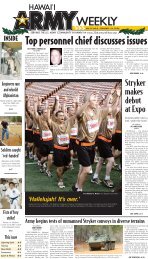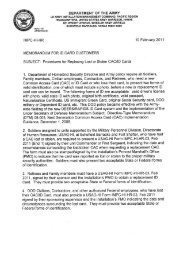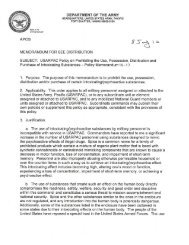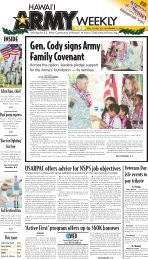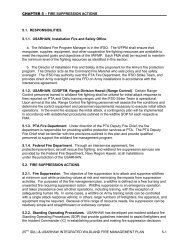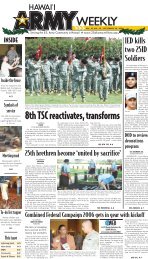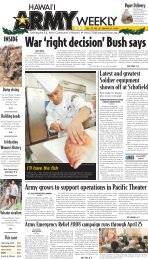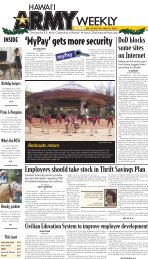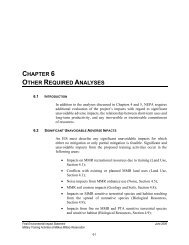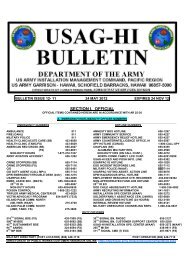Cover, Executive Summary, Table of Contents - U.S. Army Garrison ...
Cover, Executive Summary, Table of Contents - U.S. Army Garrison ...
Cover, Executive Summary, Table of Contents - U.S. Army Garrison ...
Create successful ePaper yourself
Turn your PDF publications into a flip-book with our unique Google optimized e-Paper software.
Water Resources<br />
<strong>Executive</strong> <strong>Summary</strong><br />
Given the number <strong>of</strong> proposed projects in the Cantonment Area that would create more artificial/hardened<br />
surfaces, stormwater would need to be closely managed and mitigated to reduce the potentially significant<br />
impacts from soils migration, sedimentation, and minor flooding within and outside construction areas.<br />
Geology and Soils<br />
The terrain at the proposed IPBA location southwest <strong>of</strong> Range 20 is thought to be extremely rugged and<br />
would require substantially more ground s<strong>of</strong>tening, grading, and leveling at a premium cost over the other<br />
two IPBA alternatives.<br />
Construction activities in the Cantonment Area such as site clearing and grading for newly proposed<br />
facilities would expose soils to enhanced erosion by water and/or wind. This impact could be mitigated<br />
through the use <strong>of</strong> standard erosion control practices and possible development <strong>of</strong> an erosion control plan<br />
(because the large amount <strong>of</strong> construction expected to occur).<br />
Biological Resources<br />
Implementation <strong>of</strong> the IPBA and other modernization projects at PTA could result in potentially<br />
significant impacts from the spread <strong>of</strong> invasive species. Movement <strong>of</strong> equipment into Hawaiʻi from the<br />
continental U.S. or foreign ports, as well as from other islands or sub-installations within Hawaiʻi, would<br />
increase the likelihood <strong>of</strong> invasive plant and animal introductions. Construction activities can introduce<br />
invasive species and other weeds through the use <strong>of</strong> sand and gravel that contains plant seeds and by<br />
equipment and vehicles carrying invasive plant material from <strong>of</strong>fsite locations. The spread <strong>of</strong> invasive<br />
species would have both short and long-term impacts on vegetation resources and sensitive plants and<br />
wildlife. The <strong>Army</strong> would implement mitigations to reduce the level <strong>of</strong> significance from the spread <strong>of</strong><br />
invasive species (e.g., applying currently used and effective management controls to new range<br />
construction, and continue instituted controls through the use <strong>of</strong> wash racks).<br />
Federally-listed plant species were found to occur in the Western Range Area and Charlie’s Circle IPBA<br />
locations, and may occur (unsubstantiated to date) southwest <strong>of</strong> Range 20. Adverse effects may occur<br />
resulting from range construction and/or operation to these species at these locations, but potentially<br />
could be mitigated through conservation and avoidance measures. Additional Federally-listed species that<br />
may be present at PTA, such as the Hawaiian hoary bat or the nene, could be potentially impacted by<br />
habitat alteration.<br />
Cultural Resources<br />
Surveys covering all <strong>of</strong> the preferred IPBA alternative and part <strong>of</strong> the Charlie’s Circle alternative found a<br />
number <strong>of</strong> sites that are currently undergoing Section 106 consultation. While surveys have not been<br />
conducted for the alternative located southwest <strong>of</strong> Range 20, the <strong>Army</strong> believes it is possible for similar<br />
sites to be found there as well. Significant and irreversible impacts could occur to resources in these<br />
areas. The <strong>Army</strong> will continue to consult with the Hawaiʻi State Historic Preservation Officer (SHPO)<br />
and reach to other consulting parties, including Native Hawaiian organizations, on potential mitigation,<br />
preservation, and avoidance measures.<br />
Draft Programmatic Environmental Impact Statement ES-9<br />
Modernization <strong>of</strong> PTA and Construction and Operation <strong>of</strong> an IPBA



